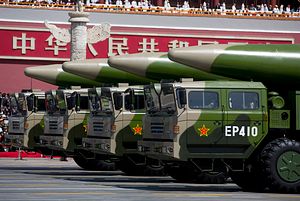By Ankit Panda
 Over at Popular Science, Peter W. Singer and Ma Xiu draw attention to China’s DF-26 intermediate-range ballistic missile (IRBM). The DF-26 is not only notable for being a system tailor-made for payload delivery to the U.S. territory of Guam, but for its dual capability. It is currently the longest-range system in the People’s Liberation Army Rocket Force explicitly designed for compatibility with conventional and nuclear payloads alike.
Over at Popular Science, Peter W. Singer and Ma Xiu draw attention to China’s DF-26 intermediate-range ballistic missile (IRBM). The DF-26 is not only notable for being a system tailor-made for payload delivery to the U.S. territory of Guam, but for its dual capability. It is currently the longest-range system in the People’s Liberation Army Rocket Force explicitly designed for compatibility with conventional and nuclear payloads alike.
As Singer and Ma note, this creates more than a few dangerous scenarios: for instance, in a conflict, the United States would be tempted to target DF-26 battalions to ensure that it could sustain operations into the Western Pacific and past the First Island Chain from its military facilities on Guam. But conducting such an attack would amount to nuclear counterforce given that any given DF-26 launcher could play a role for nuclear retaliation by China.
A separate scenario concerns China launching a conventional DF-26 during a conflict. With space-based early warning sensors able to notify the United States of a launch, planners may reason that such a launch could be a nuclear one. Here, China’s stated posture of No First Use might have little to do in shaping U.S. assumptions, especially as many in the U.S. government (certainly in the Trump administration) already view China’s No First Use declaration with skepticism.
This “pre-launch ambiguity” problem is very much a feature for the DF-26, however, and not a bug, per se (see a recent monograph on this topic by James Acton for more). Singer and Ma draw attention to a fascinating CCTV report from a few years ago that boasts of the dual-capable nature of a missile presumed to be the DF-26. According to their translation of Zhou Lusheng, a brigade political commissar, cited in the report: “Our mission is the two major operations, the two major deterrences [a reference to both nuclear and conventional capabilities]… A nuclear-conventional dual-use brigade must train to simultaneously possess two different operational postures… meaning that personnel of such a brigade have a higher workload.”
Even more interesting is the training procedure described in the article. According to the authors, “The article even describes a drill in which the brigade practices firing a precision missile, then rapidly switches over to a nuclear posture for a counter-strike mission.” People’s Liberation Army Rocket Force (PLARF) training protocols are known to only involve nuclear exercises that simulate retaliatory strikes (to keep No First Use credible) so the implication in this exercise is that a conventional DF-26 strike might invite nuclear use from an adversary.
In the end, the co-mingling of conventional and nuclear capabilities is designed to create a calculated form of ambiguity that might cause the United States to think twice. There’s some evidence that American planners are taking these risks seriously. The U.S. Department of Defense’s 2019 report on Chinese military capabilities emphasized the ambiguity problem, including by drawing attention to internal debates on how China’s doctrine might need to be modified.
“Some PLA officers have written publicly of the need to spell out conditions under which China might need to use nuclear weapons first; for example, if an enemy’s conventional attack threatened the survival of China’s nuclear force or of the regime itself,” the 2019 report notes, adding, “There has been no indication that national leaders are willing to attach such nuances and caveats to China’s existing NFU policy.”
“China’s commingling of some of its conventional and nuclear missile forces, and ambiguities in China’s NFU conditions, could complicate deterrence and escalation management during a conflict,” the 2019 report added. “Once a conflict has begun, China’s dispersal of mobile missile systems to hide sites could further complicate the task of distinguishing between nuclear and conventional forces and, thus, increase the potential for inadvertent attacks on the latter.”
It remains unknown how the Chinese leadership precisely views the question of retaliating for conventional, long-range precision strike on dual-capable strategic systems like the DF-26, but the capability for the system itself is an important feature. The United States and China remain no closer to the sort of dialogue on strategic stability that would allow for an authoritative qualification by the Chinese side on how it views this important question.
No comments:
Post a Comment